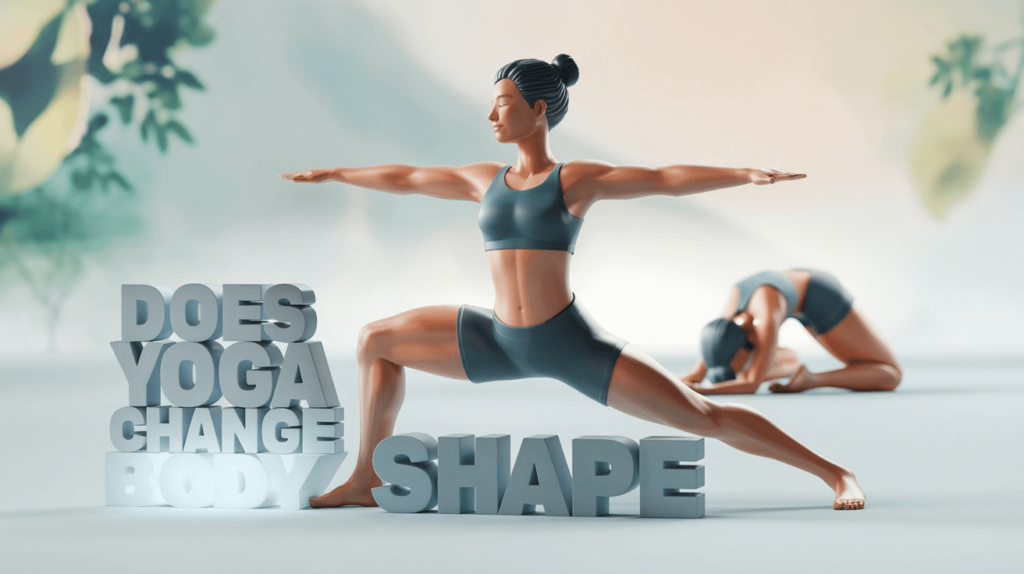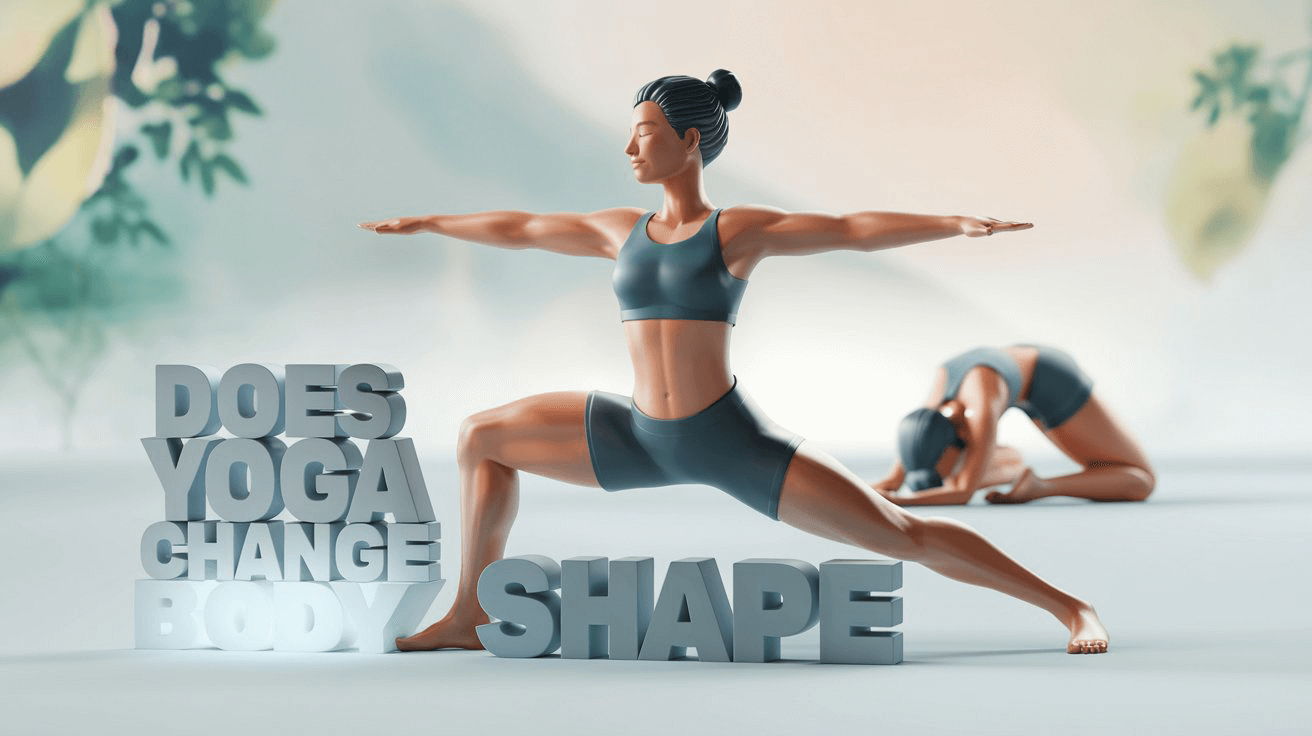
Introduction
Comprehending the connection between yoga and your body figure is a must for everyone who wants to get a better physical embodiment. Yoga and the perfect combination of physical postures, breathing techniques and meditation, is actually a vital factor that can greatly affect muscle toning and flexibility.
Regular power not just tones the muscles but also corrects the body shape that is out of balance. Being regular in the yoga practice is an important part of the process of making these changes over time.
Yoga involves the body’s disruption and subsequent reconstruction of itself, and through such process the physical health changes are experienced. The breath that fills you up, and changes in your posture as you practice are the visual cues that confirm the yoga’s effect on your body.
1. How Yoga Influences Muscle Tone
When we talk about improvements of the muscle tone, yoga is first in the list, which works under the fact of various poses, or asanas. These poses are like Swiss knives, so they can perform several functions in one go. That is to say, these exercises will cause the muscles to elongate while at the same time to make you stronger. Balancing muscle strength is important because practicing yoga will promote lean muscle mass along with increased flexibility. It is known that yoga poses are the key to defined muscles.
The up dog is a position that defines the upper body muscle tone. Breathing exercises in yoga are also beneficial and are the best things for muscle toning.
Using yoga allows proper extending of the hip flexors and getting the full range of the motion in the hip pelvic area. These poses are not just about physical strength and flexibility, but about mental and emotional strength as well: headstand (supported or unsupported), wheel, and pigeon.
- Plank Pose (Phalakasana):
- Works out the core, shoulders, arms, and legs.
- Aids in bringing stability and endurance to the abdominal muscles.
- Is beneficial for the upper body’s strength.
- Warrior Pose (Virabhadrasana):
- It power the legs, glutes, hips, and core.
- Better the balancing of coordination.
- Consists of the lower anatomy muscles as a set of respite and resistance of muscle groups.
- Chaturanga Dandasana:
- Targets triceps, chest, shoulders, and core.
- The pose also helps in moving from other poses such as Upward-Facing Dog to Downward-Facing Dog and vice-versa.
- Develops arm strength and increases muscle tone in the upper body.
Key Poses for Muscle Engagement
Let’s take a closer look at the essential yoga poses and their individual effects on the different muscle parts:
Plank Pose (Phalakasana)
Muscle Groups: Core (rectus abdominis, transverse abdominis), shoulders (deltoids), arms (biceps and triceps), legs (quadriceps).
Benefits:
- Strength: Gaining strong muscles in the upper body can be achieved by doing the exercises that target multiple muscles simultaneously.
- Toning: The enhancement of core stability that is one of the essential requirements for body toning is the main benefit derived from this exercise.
- Endurance: Besides, one acquires greater muscular endurance from the continuous contraction of the muscles in such a pose.
Warrior Pose (Virabhadrasana)
Muscle Groups: Legs (quadriceps, hamstrings), glutes, hips, core (obliques).
Benefits:
- Strength: Strengthens the lower body muscles through maintained participation.
- Toning: Tones the leg muscles and helps with equilibrium at the same time.
- Stamina: Hardens stamina in the process of the demand for keeping the posture for long time.
Chaturanga Dandasana
Muscle Groups: Arms (triceps), chest (pectorals), shoulders (deltoids), core.
Benefits:
- Strength: Building the upper body strength which is essential for more demanding yoga postures.
- Toning: The arms and chest not only burn fat but also gain definition through properly activating muscles in these areas.
- Transition: The move in the beginning makes the body flexible enough so that it can move into other more intense positions like Upward-Facing Dog.
The Role of Regular Practice in Building Strength and Lean Muscle
Apart from the physical aspect of yoga, one of the most obvious ways to see muscle tone change in your body through yoga is to comply with a consistent practice routine. Executing these asanas frequently contributes to the following:
- One can construct lean muscles gradually, but without the extra load of the mass, so that he/she can be in better shape due to it.
- Prompt muscle security is achieved by attempts and by tightening the positions for a few seconds at a time.
2. The Role of Posture in Body Shape Change
How Yoga Strengthens Muscles Around the Spine to Enhance Posture
Highly effective yoga to give the back to the extrinsic muscles is a kind of an upright yoga which not only promotes the proper posture but also the spine is guided(radically decreased) through the back. Many yoga taos, such as Mountain Pose (Tadasana) and Downward-Facing Dog (Adho Mukha Svanasana), are the kinds that are the basic core workouts for supporting the whole spine, that include the core muscles. This awareness of correct alignment of the body results not only in a strong body but also in stability.
The Connection Between Good Posture and Perceived Body Shape
Standing straight is another example of how a person’s body can be deceptive. Good posture makes you look taller and thinner by keeping your back and neck straight and curving them less. Stretched yoga exercises are a good solution for such workouts. An ongoing yoga session enables you to sustain this good posture thereby making you look way better than you used to.
Long-term Benefits of Improved Spinal Alignment on Overall Body Shape
Long-term benefits of improved spinal alignment include:
- Lessen Back Pain: As a matter of fact, the purpose of muscle strengthening in the spine area is to relieve the pressure on the lower back.
- Greater Movement: Since spine alignment is more reliable, it causes flexibility and range of motion to be achieved.
- Proportional Body: The right alignment of the body ensures that all sets of muscles are evenly employed which in turn guarantees the body achieves a proportional build.
Correcting Postural Imbalances Through Yoga Practice
Postural imbalances such as rounded shoulders or a forward head posture are the common problems that deform body shapes. Yoga works out these imbalances through specific exercises that improve the muscle balance symmetry and alignment of the body.
Common Postural Issues Addressed by Yoga
- Rounded Shoulders:Pose:Chest Opener (Ustrasana)
- Benefit: Stretches chest muscles, strengthens upper back
- Forward Head Posture:Pose: Bridge Pose (Setu Bandhasana)
- Benefit: Strengthens neck and upper back muscles
- Anterior Pelvic Tilt:Pose: Cat-Cow Pose (Marjaryasana-Bitilasana)
- Benefit: Engages core muscles, realigns pelvis
Importance of Maintaining Proper Alignment for a Balanced Physique
A correct body alignment is the primary condition for creating a balanced body. The misalignments can in fact make the certain groups of muscles use more force than they need to, in-turn, causing the uneven development of the muscles. Overtraining may occur and bones and muscles may be injured at a higher risk.
- Full Body Engagement: Poses like Plank require all the muscle groups to work together.
- Injury Prevention: Proper posture decreases pressure on the joints.
- Enhanced Performance: Properly developed muscle balance is an advantage for physical performance.
By focusing on the habitual practice of yoga to correct posture, you can have a positive effect on your body shape.
3. Fat Loss Through Yoga Practice: Myth or Reality?
Indeed, some specific types of yoga can be connected with the release of fats, though they do not usually require the expenditure of as many calories as high-intensity workouts do. Lovely that can be used in yoga are Vinyasa and Ashtanga to boost metabolism and thus reduce body fat.
How Vinyasa & Ashtanga Styles Allow for Improved Metabolism and Fat Burning
Vinyasa Yoga
Vinyasa yoga involves a series of flowing postures synchronized with breath. . The continuous moving of the body subsequently raises the heart rate, thus speeding up the metabolic rate to boot the burning of food provided with increased oxygen, supportless calories, and also reducing body fat. The very dynamic feature of Vinyasa makes it become an effective style for those who want to consume more calories and lose fat in the body consistently.
Ashtanga Yoga
Ashtanga yoga, a more structured and intense form, follows a definite order of poses. This method is used the most for those who have toughened their training but also to the people who are sick and tired of unhealthy food. The ultimate reason behind this is that such high-impact activities require a propulsive input of air. In this method, the movements passed some essential postures in a given system majorly referred to Asanas, Yoga postures.
How Yoga Helps Reduce Stress, Emotional Eating, and Body Shape Changes
Stress plays a significant role in weight gain and body shape changes. Cortisol levels are raised through high-stress exposure, which may lead fat storage in the abdominal area. The calming effects of yoga in relation to stress can play a huge role in fixing these conditions.
Reduced Stress from Yoga Practice
Regular yoga practice not only helps to lower cortisol levels by promoting relaxation and mental clarity but it also supports hormonal balance, which in its turn does away with fat in a more effectual way over time.
Mindfulness through Yoga
Mindfulness practices embedded in yoga encourage a deeper awareness of the body and mind connection. This heightened awareness can profoundly influence eating habits.
- Impact on Eating Habits: Yoga participants trained to meet mindfulness become those who choose to eat better. They are more in tune with hunger signals and are less likely to engage in emotional eating behaviors.
- Mitigating Emotional Eating: Emotional eating very often results from stress or negative emotions. Yoga as a form of relaxation will decrease the risks of use of food as the way to come down.
In the context of doing yoga, even if a person expends fewer calories than a high-intensity exercise, yoga benefits are more than mere physical exertion. Through combining physical postures and mindfulness practices, yoga considers the whole human being and its resulting a balanced body shape that is achievable through both reduced fat and improved mental well-being.
4. Flexibility: A Key Player in Achieving a Balanced Body Shape with Yoga Practice?
A consistent yoga practice can produce profound changes in muscles’ function and appearance through the increased flexibility in them. Stretching poses elongate the muscles, in this way, they can be the main tension-reducers and enhancers of the overall muscle tone. This makes your body appear more defined, lines are more visible and the body looks slender and in youthful shape.
Importance of Stretching Poses
The secret to a leaner appearance is inclusivity of stretching poses. This enables them to prolong time of tight muscles, widen the range of motion, and increase the Lexemes score. Furthermore, they also play a role in maintaining the equilibrium of muscle fibers. This brings about, in addition, biomechanical transportation of the lower limbs while flexible, thus, efficient mobility results in posture and overall body coordination that is healthy.
Targeted Poses for Enhancing Flexibility with Yoga Practice for Body Shape Improvement
Various yoga postures take on the flexibility target of different body parts. They’re not only for flexibility but also very important in shaping the various muscle groups.
Downward Dog Pose (Adho Mukha Svanasana)
- Targets: Shoulders, hamstrings, calves
- Benefits: Enhances overall body flexibility and strength. Improves shoulder stability and stretches the entire backline of the body.
- How to Do It: Start on your hands and knees, tuck your toes under, lift your hips towards the ceiling, and straighten your legs while pressing your heels towards the floor.
Bridge Pose (Setu Bandhasana)
- Targets: Glutes, lower back, hip flexors
- Benefits: Strengthens the glutes and lower back while stretching the hip flexors. Promotes a balanced pelvis alignment.
- How to Do It: Lie on your back with knees bent and feet flat on the floor. Lift your hips towards the ceiling while pressing your feet into the ground.
Pigeon Pose (Kapotasana)
- Targets: Hips, glutes
- Benefits: Deeply stretches the hip flexors and glutes. Helps release tension stored in these areas.
- How to Do It: From Downward Dog, bring one knee forward towards your wrist while extending the other leg straight back. Lower your hips towards the mat and fold forward over your front leg.
- For more detailed instructions on this pose, you can refer to reliable health sources.
Seated Forward Bend (Paschimottanasana)
- Targets: Hamstrings, lower back
- Benefits: Stretches the spine and hamstrings. Improves flexibility along the posterior chain.
- How to Do It: Sit with legs extended straight out. Inhale to lengthen your spine, then exhale as you reach forward towards your feet.
Cow Face Pose (Gomukhasana)
- Targets: Shoulders, triceps
- Benefits: Opens shoulders and chest while improving arm flexibility.
- How to Do It: Sit with one knee stacked over the other. Reach one arm up and over behind you while reaching the other arm up from below to clasp hands together.
Including these exercises in a normal yoga schedule will make a difference in the shape of the body by adding flexibility to different muscle groups majorly. Flexible muscles not only make us look longer and slimmer, but they also make our bodies move in a better and more proper manner thus contributing to a balanced physique on the whole.
5. Consistency is Key: Why Regular Yoga Practice Matters for Lasting Body Shape Changes?
Repetition and thorough yoga are necessary to bring about physical improvements over a period of time. Although this rule is present in fitness in general, it is the most suitable in yoga that the advantages escalate one gradually with the constant work you do.
The Necessity of Regular Practice
- Muscle Memory and Adaptation: Through the constant revival of your muscles to the issues they get during different asanas (yoga poses), they slowly but surely adapt to the process. This changing in the muscles leads to increasing muscle tone and muscle definition.
- Flexibility Gains: With regular stretching and holding of poses, flexibility can be enhanced. The rolling of the flex is seen to result in a person getting a leaner and a more toned look.
- Mindfulness and Stress Reduction: Regular practice induces mindfulness leading to low stress and then low cortisol production. Lower cortisol can result in fat reduction.
Combining Yoga with a Balanced Diet
Receive all the benefits of a balanced diet and strength yoga to the maximum level in your desired body:
- Nutrient Intake: Adequate protein intake helps us by supporting our muscles with a means of repair and growth and vitamins and minerals by assisting in the overall bodily functions of our bodies.
- Caloric Balance: To keep a caloric balance is a way that your body’s energy needs are met without storing excess calories as fat.
- Hydration: Proper hydration is the key to muscle function and recovery, this is accomplished by providing your body with the right fluid so that proper performance is guaranteed through your training session.
Embracing Individual Variability: Understanding You Unique Journey with Yoga and Body Shape Transformation
Other factors include that of physical characteristics such as lifestyle and dietary preferences which can stimulate these effects yoga wears on the shape of our body.
Body Type Variations
- Ectomorphs: Usually, those who are leaner with faster metabolisms. They may find it easier to achieve a toned appearance but might have to concentrate on building muscle mass through strength-focused poses like Plank and Warrior.
- Endomorphs: More often than not, people maintain higher body fat percentages. They may want to include other Vinyasa or Ashtanga styles to stimulate their metabolism as well as yoga practice.
- Mesomorphs: Naturally muscular and well-proportioned body. If you are naturally muscular, you might notice that you get faster muscle definition, but must keep up with the routine so that you won’t reach a plateau.
Lifestyle Factors
- Activity Level: Those who live a sitting lifestyle probably need more physical activities at the time to fight against the impacts of inactivity.
- Stress Levels: High stress could be a problem for us because the cortisol levels will go up; we can get this priority at work by changing shift. Integrating restorative yoga practices would be beneficial. Awareness on how
- Dietary Choices: A nutrition-rich, meticulously planned eating schedule during yoga is not only very important but is crucial to the success of this exercise routine concept.
Acknowledging these individual differences enables us to develop a customized approach in such a way that your way through yoga will be in line with your unique needs as well as goals. Developing regular training in conjunction with being aware of what you are eating will not only help you lose weight but also keep it off for a long time.
These basic concepts allow for clear expectations and motivations for a personal yoga journey, since the participants understand them.
Conclusion
Yoga is a process of reconnection which implies that there is a change over the body and it also includes the general well-being of an individual. By doing it regularly, you can slowly change your body through the improved flexibility, strength, and muscle definition. The mindfulness part of yoga additionally includes a healthier dietary and stress-free lifestyle, which consequently results in weight balance and body composition that is more favorable.
Your way of doing yoga might be different giving outcomes that are unique and then you can also identify these goals from your journey. Maybe you are asking “Is yoga a guaranteed body shape changer?” or are think about general health. Yoga gives you the way utilizing your body and transformation in other areas to change those things in life that you are not happy with.
FAQs (Frequently Asked Questions)
Does yoga change body shape?
Yep, yoga is able to do that with the help of muscle tone strengthening, improved posture, and looser joints. The gradual improvement of these will show in the body as a well-toned physique and an overall healthier appearance.
How does yoga influence muscle tone?
Yoga involves many groups of muscles and various postures, etc. such as Anjaneyasana, Virabhadrasana, and Chaturanga. These asanas, specifically, are effective in muscle strengthening and growth, so the muscle gains noticeable definition.
What role does posture play in body shape change?
The proper form is necessary for the change of body shape. Yoga strengthens the muscles of the spine, which are responsible for a proper vertebral alignment. Thus, an individual might look taller and leaner while the effect of improved body shape is lasting.
Can yoga help with fat loss?
Yoga might not burn as many calories as high-intensity training; however, certain types of yoga like Vinyasa and Ashtanga can jack up the metabolism and help in fat burning. Furthermore, yoga’s stress-relieving effect may help to curb emotional eating habits.
How does flexibility impact body shape with yoga?
Flexibility, which typically arises from yoga, slowly changes the muscle function and appearance. Stretching exercises e.g. Downward Dog and Bridge Pose give slimmer or neater features by improved all over movement.
Why is consistency important in yoga practice for lasting body shape changes?
For a visible body change, longevity in training is significant. The correct pairing of the consistent yoga program with a healthy diet multiplies the effect. Some of the effects such as body type and lifestyle choices are equally important in determining if yoga would be effective in the body shaping transformation.




